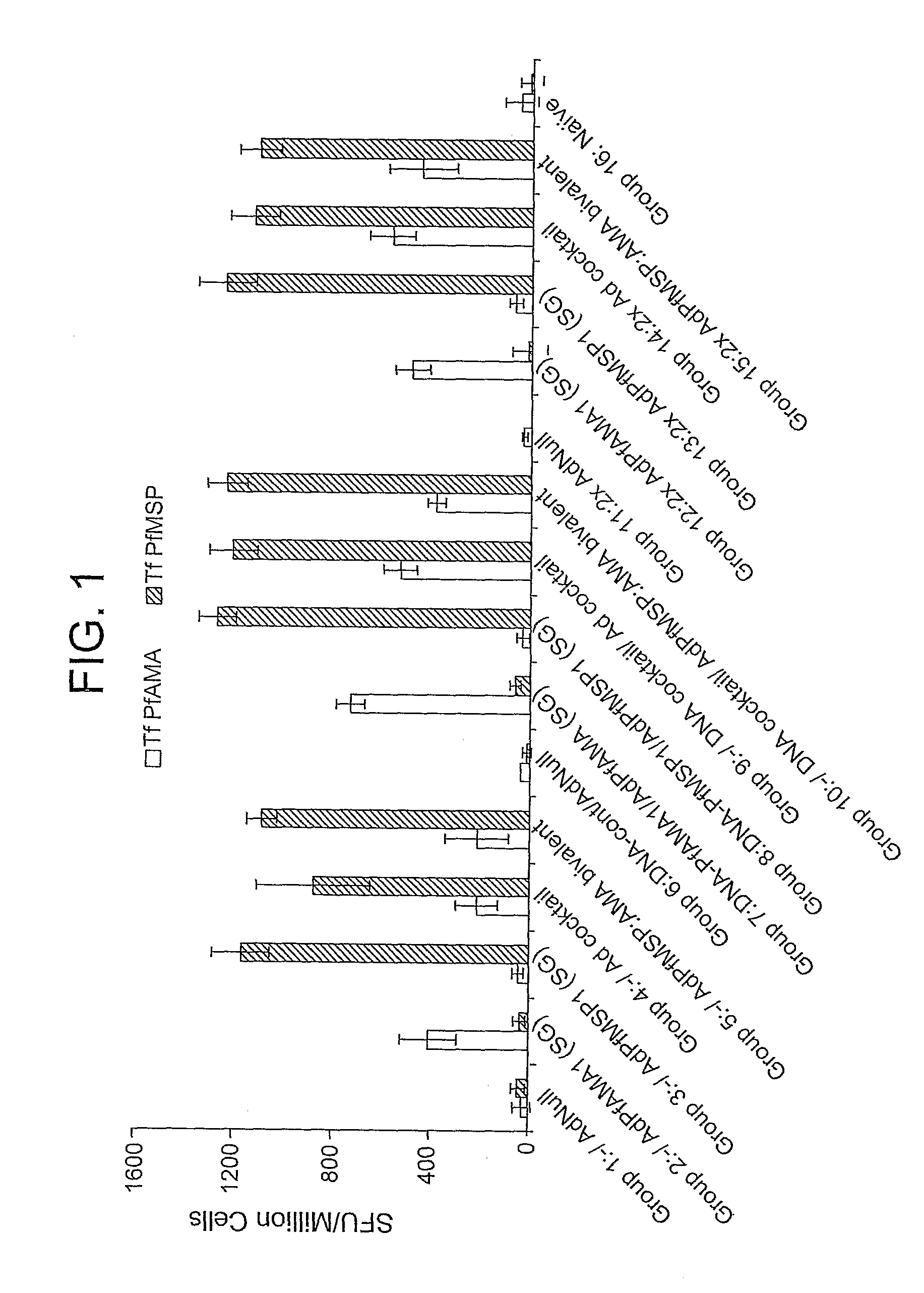Adenoviral vector-based malaria vaccines
a technology of adenoviral vectors and malaria vaccines, applied in the field of adenoviral vector-based malaria vaccines, can solve the problems of high non-compliance rate, limited efficacy of these agents, and the failure of malaria vaccine research and development for decades
- Summary
- Abstract
- Description
- Claims
- Application Information
AI Technical Summary
Benefits of technology
Problems solved by technology
Method used
Image
Examples
example 1
[0098]This example demonstrates the preparation of an adenoviral vector comprising a heterologous nucleic acid sequence encoding a P. falciparum blood-stage antigen.
[0099]Ten serotype 5 E1 / E3 / E4-deficient adenoviral vectors containing, in place of the deleted E1 region, a nucleic acid sequence encoding non-secreted (NS), secreted and glycosylated (SG), and secreted and non-glycosylated (SNG) versions of the P. falciparum AMA-1 (PfAMA1) and MSP-142 (PfMSP142) proteins were generated. The SG version of PfMSP142 was generated by fusing the decay-accelerating factor (DAF) signal sequence to the 5′ end of the PfMSP142 gene. The SNG version of PfMSP142 contains the DAF signal sequence and an asparagine to glutamine substitution at amino acid position 321. The SG version of PfAMA1 is the full-length PfAMA1 gene. The SNG version of PfAMA1 contains asparagine to glutamine substitutions at amino acid positions 286, 371, 421, 422, and 499, and an asparagine to lysine substitution at amino acid...
example 2
[0107]This example demonstrates the immunogenicity of an adenoviral vector comprising a heterologous nucleic acid sequence encoding a P. falciparum blood-stage antigen.
[0108]Four serotype 5 E1 / E3 / E4-deficient adenoviral vectors containing, in place of the deleted E1 region, a nucleic acid sequence encoding non-secreted (NS), secreted and glycosylated (SG), secreted and non-glycosylated (SNG), and wild-type versions of the P. falciparum MSP142 (PfMSP142) or AMA-1 (PfAMA1) proteins were generated as described in Example 1. To anchor the MSP142 proteins to the cell membrane, the nucleic acid sequences encoding the NS, SG, and SNG versions of Pf MSP142 also contained a glycosylphosphatidylinisotol (GPI) anchor sequence. Similarly, the wild-type MSP142 nucleic acid sequence contained the DAF anchor sequence and the DAF signal sequence (i.e., Ad.PfMSP142(DSA)). In addition to the secreted and non-glycosylated (SNG) version of PfAMA1 described in Example 1, a second SNG PfAMA1 adenovector ...
example 3
[0112]This example demonstrates the effect of promoter type, as well as promoter location and orientation, on expression of Plasmodium antigens encoded by an adenoviral vector in vivo and in vitro.
[0113]The use of multiple copies of a single strong promoter to express different antigens in a multivalent vector is expected to lead to vector instability due to homologous recombination between the promoters. Therefore, to identify suitable promoters for a multivalent adenoviral vector-based malaria vaccine, a set of adenoviral vectors expressing luciferase from various promoters was screened in mice to identify promoters suitable to control expression of Plasmodium genes. Specifically, cohorts of five female C57BL / 6 mice were injected with 1×1010 particle units pu) of an E1 / E3 / E4-deficient adenoviral vector containing a luciferase expression cassette at the site of the E1 deletion. The luciferase gene was operably linked to each of the following promoters: a human CMV promoter (hCMV), ...
PUM
| Property | Measurement | Unit |
|---|---|---|
| total volume | aaaaa | aaaaa |
| volume | aaaaa | aaaaa |
| resistance | aaaaa | aaaaa |
Abstract
Description
Claims
Application Information
 Login to View More
Login to View More - R&D
- Intellectual Property
- Life Sciences
- Materials
- Tech Scout
- Unparalleled Data Quality
- Higher Quality Content
- 60% Fewer Hallucinations
Browse by: Latest US Patents, China's latest patents, Technical Efficacy Thesaurus, Application Domain, Technology Topic, Popular Technical Reports.
© 2025 PatSnap. All rights reserved.Legal|Privacy policy|Modern Slavery Act Transparency Statement|Sitemap|About US| Contact US: help@patsnap.com



